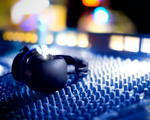What is the most important step in designing a sound system? Of course, every step is important, but I might argue that the final equalization is perhaps the most critical step, and often the most overlooked. Assuming a good design has been put together on paper and that the system has been installed as it was intended to be, it’s then time to put the finishing touches on everything. Equalizing (or commissioning) a large sound system is the final step in this complex process.
The best sound system results are obtained when the system designer is integrally involved in the sound system commissioning. An experienced audio-visual designer will have in mind how they intend to set different parts of the system in order to achieve full optimization. Once the physical alignment of the loudspeakers has been verified to be optimal, electronic testing can begin to optimize the signals going to the loudspeakers.
A Digital Signal Processor (DSP) is a “black box” that controls, routes, distributes and shapes the signals that will go to each of the various loudspeakers (via the amplifiers) in the system. The DSP is usually programmed with a computer and has a variety of “devices” that can be arranged in any order and configuration to apply delay, equalization, filtering, and other types of processing to the signal. A computer-based test software hooked up to a reference microphone is used to provide visual information about the sound coming from the loudspeaker. The engineer sends test signals through the system and then observes the loudspeaker response on the computer. Based on these observations the engineer can make adjustments to the settings in the DSP to optimize the loudspeaker response.
An excellent system design can easily have a horrible outcome if not setup correctly. Complex systems typically require a deep understanding of the components being used, a firm grasp of the design intent, quality test gear to be able to objectively quantify the system performance, experience to correctly read and understand the test gear, and a good set of ears to listen to the system. This last item is probably the most important. Even with the many excellent tools available to us today, the sound system still has to sound good to the naked ear. At the end of the day the best piece of test equipment is the one on top of your shoulders.
If you are looking for better ways to optimize your sound system, contact Acoustics By Design. We are independent design consultants, and since we do not sell any products, we can offer the most objective advice.
